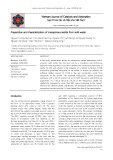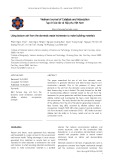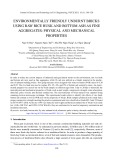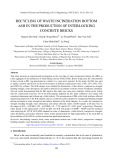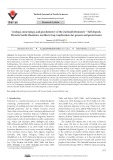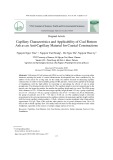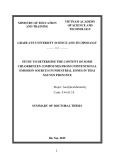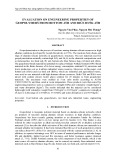
Bottom ash
-
In this study, experimental results on mesoporous zeolite preparation from a common solid waste, the rice husk ash by a top-down and bottom-up approach were reported. In top-down method, the consecutive treatments of zeolite by acid and alkaline in the presence of a cationic surfactant (CTAB) successfully generated mesopores in the zeolite.
 6p
6p  vikwong
vikwong
 29-09-2024
29-09-2024
 4
4
 1
1
 Download
Download
-
This paper researched the use of ash from domestic waste incinerators to generate electricity and blast furnace slag for civil construction materials. Due to the presence of heavy metal elements in the ash from the domestic waste incinerator and the blast furnace slag, its use is limited.
 7p
7p  vikwong
vikwong
 29-09-2024
29-09-2024
 3
3
 1
1
 Download
Download
-
In this study, raw rice husk and bottom ash are used as fine aggregates, while fly ash is used as a binder material in the production of environmentally friendly unfired building bricks. The effect of raw rice husk content on the properties of green building bricks is investigated.
 11p
11p  vifilm
vifilm
 24-09-2024
24-09-2024
 6
6
 1
1
 Download
Download
-
This study presents an experimental investigation on the recycling of waste incineration bottom ash (IBA) as a fine aggregate in the production of interlocking concrete bricks (ICB). Before being used, the concentration of heavy metal in IBA was determined to confirm it is a non-toxic material.
 12p
12p  vifilm
vifilm
 24-09-2024
24-09-2024
 3
3
 1
1
 Download
Download
-
The Quaternary Zarloukh Bentonite –Tuff (ZBT) deposit occurs within the Hemrin South Mountain, northern Iraq. The ZBT deposit occurs as depression-filling exposed on the erosional surface of the siliciclastic Pliocene Muqdadiya Formation and covered by an overburden of recent sediments. The thickness of the studied industrial bentonite bed is ~80−100 cm, occurring at the bottom of these depressions, covered by ~3−4 m thick bedded volcanic tuff, which also contains many 10–12 cm thick bentonite layers along its bedding planes.
 17p
17p  tanmocphong
tanmocphong
 29-01-2022
29-01-2022
 9
9
 0
0
 Download
Download
-
Utilization of Coal bottom ash (CBA) as well as finding the solutions to prevent saline intrusion, meeting the needs of coastal infrastructure development have been considered by the authors of the article for a long time. In this study, the authors focused on analyzing capillary characteristics in order to find a suitable group of CBA particles, which can be applied in the design of foundations with the high ability in restricting or preventing the effects of salt in saline groundwater.
 11p
11p  larachdumlanat129
larachdumlanat129
 14-01-2021
14-01-2021
 5
5
 2
2
 Download
Download
-
Research objectives of the thesis: Study the process of simultaneous determination and evaluation of the method of analyzing 7 chlorobenzene, including 1,2- 4 dichlorobenzene (1,2-DCB); 1,3-dichlorobenzene (1,3-DCB); 1,2,4- trichlorobenzene (1,2,4-TCB); 1,2,3,4-tetrachlorbenzene (1,2,3,4- TeCB), 1,2,4,5-tetraclobenzene (1,2,4,5-TeCB); pentaclobenzene (PeCB) and hexaclobenzene (HCB) in trace and superficial content in flue gas samples and industrial waste (fly ash, bottom ash, input materials).
 26p
26p  xacxuoc4321
xacxuoc4321
 08-07-2019
08-07-2019
 51
51
 9
9
 Download
Download
-
The reactions form chains and rings of alumino-silicate networks in geopolymeric structures. The raw materials used for geopolymerization normally contain high SiO2 and Al2O3 in the chemical compositions such as meta-kaoline, rice husk ash, fly ash, bottom ash, blast furnace slag, red mud, and others. The geopolymer-based material has potentials to replace Ordinary Portland Cement (OPC)-based materials in the future because of its lower energy consumption, minimal CO2 emissions and lower production cost as it utilizes industrial waste resources.
 8p
8p  quaymax4
quaymax4
 05-09-2018
05-09-2018
 29
29
 1
1
 Download
Download
CHỦ ĐỀ BẠN MUỐN TÌM









